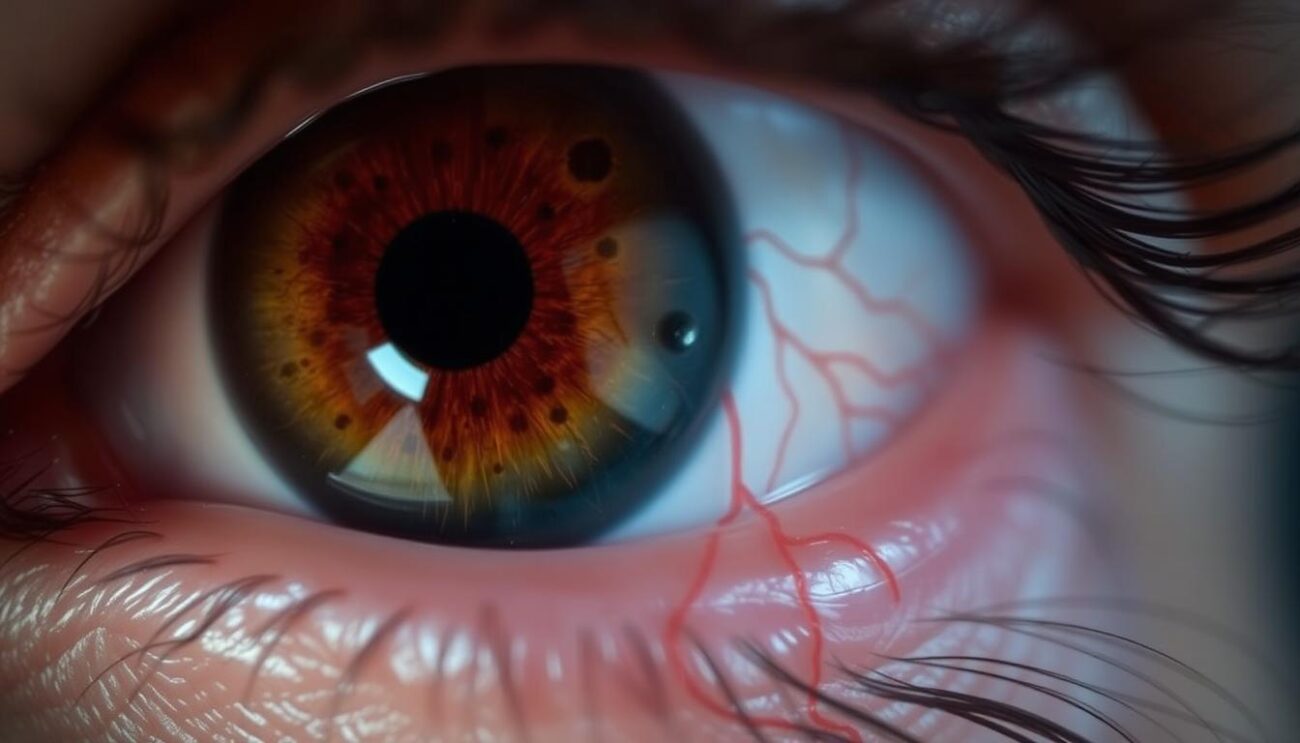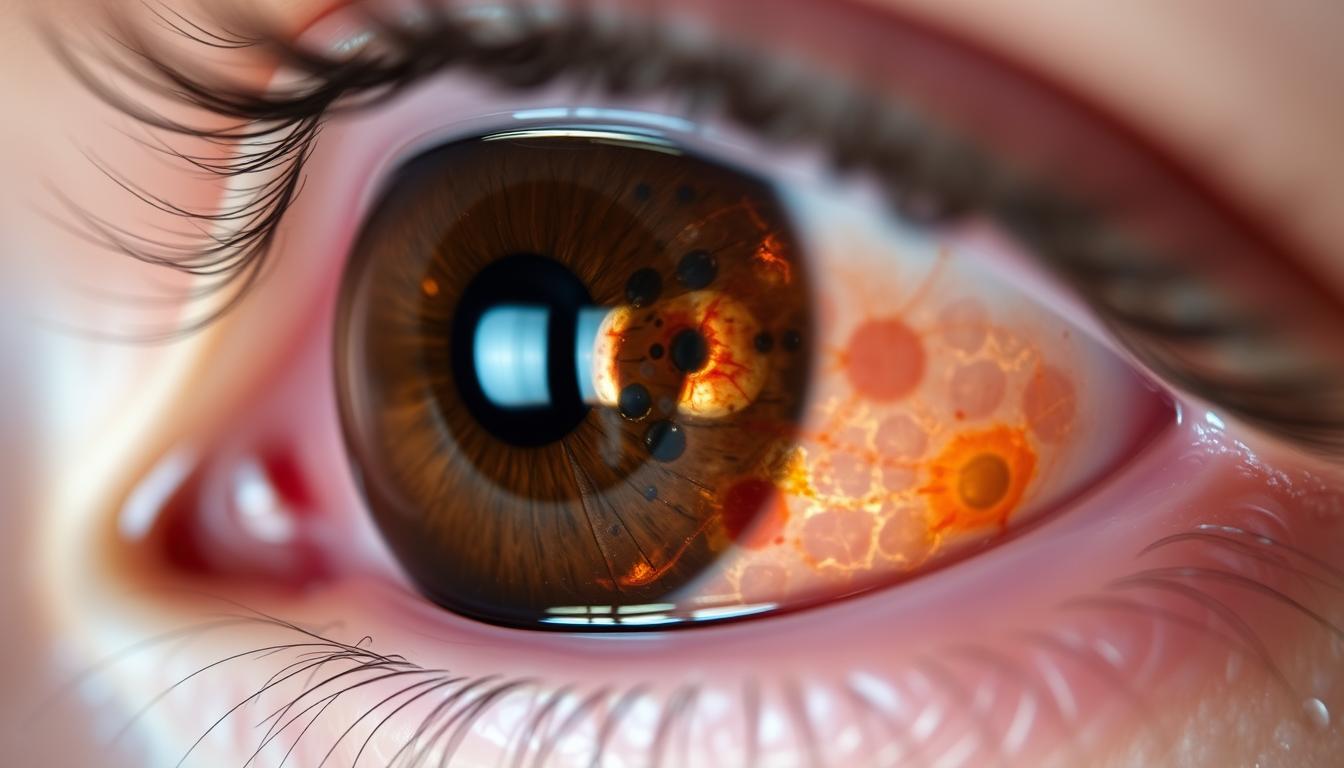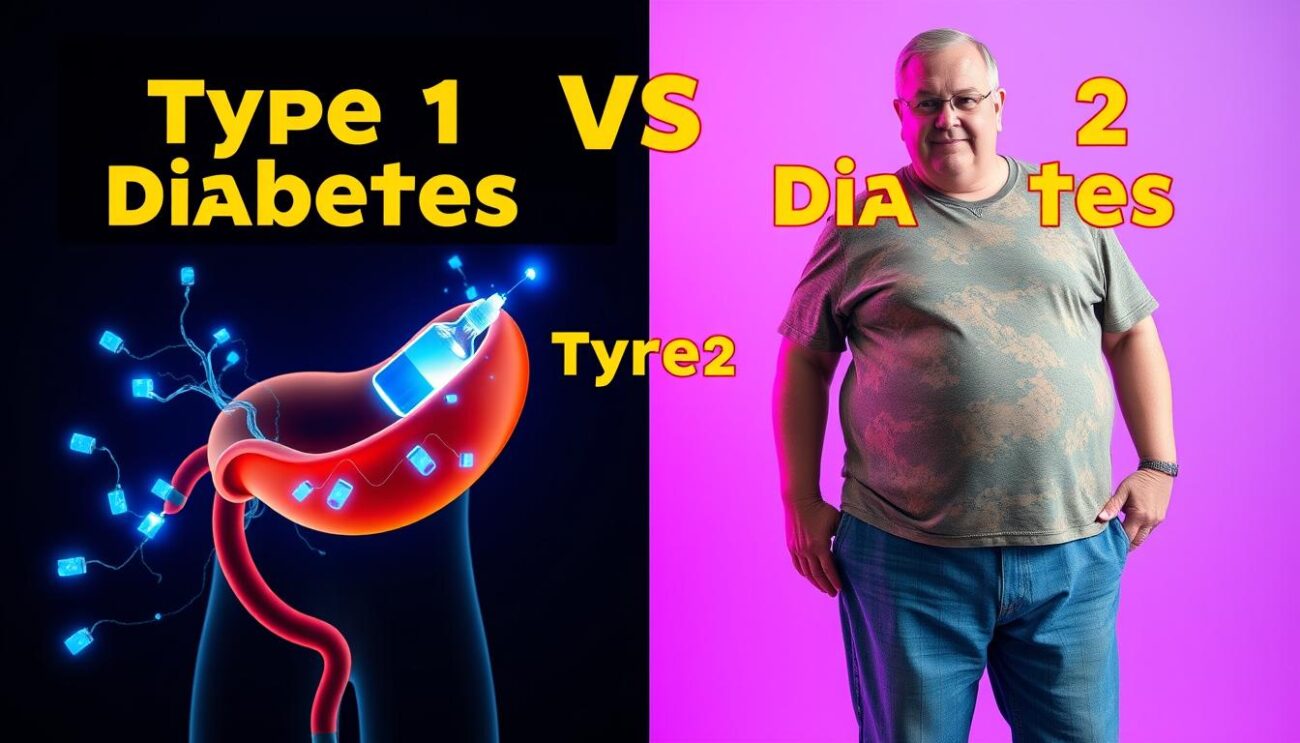Ever thought about if vision changes could mean something serious? For those with diabetes, knowing the signs of diabetic retinopathy is key. This leading cause of blindness in American adults can sneak up quietly, causing vision loss before you even realize there’s a problem. So, what are the warning signs to look out for?
Key Takeaways
- Diabetic retinopathy is the leading cause of blindness in American adults with diabetes.
- Early symptoms like floaters and blurred vision may go unnoticed, highlighting the importance of regular eye exams.
- Advanced stages of diabetic retinopathy can cause vision loss and dark areas in the field of vision.
- Prompt treatment and management of diabetes are crucial to prevent vision-threatening complications.
- Certain risk factors, such as duration of diabetes and poor blood sugar control, increase the likelihood of developing diabetic retinopathy.
Understanding Diabetic Retinopathy
Diabetic retinopathy is a serious eye condition. It happens when the retina, the light-sensitive tissue at the back of the eye, gets damaged. High blood sugar levels can harm these tiny blood vessels. This can cause blurred vision, sudden vision loss, and even blindness if not treated.
What is Diabetic Retinopathy?
Diabetic retinopathy is linked to diabetes, a chronic disease. It’s when the body can’t control blood sugar levels. Anyone with type 1 or type 2 diabetes can get it. The longer you have diabetes, the higher your risk.
Types of Diabetic Retinopathy
There are two main types of diabetic retinopathy:
- Nonproliferative Diabetic Retinopathy (NPDR): This is the early stage. The blood vessels in the retina weaken and start to leak or bleed.
- Proliferative Diabetic Retinopathy (PDR): This is the advanced stage. New, abnormal blood vessels grow on the retina’s surface. These vessels are fragile and can bleed, causing serious vision problems.
If not treated, diabetic retinopathy can lead to severe vision loss or blindness. But, catching it early and managing it can prevent or delay these problems.
“Diabetic retinopathy is the most common eye disease in people with diabetes. Regular eye exams and early treatment can help prevent vision loss.”
Early Diabetic Retinopathy Symptoms
In the early stages of diabetic retinopathy, you might not notice any symptoms at first. But as it gets worse, look out for floaters (dark spots or strings in your vision) and blurred vision. You might also see fluctuating vision, where your vision changes throughout the day.
Floaters and Blurred Vision
Floaters and blurred vision are common early signs of diabetic retinopathy. Floaters look like small dark spots, cobwebs, or strings moving in your vision. Blurred vision makes it hard to focus, read, or do daily tasks. These changes can affect one or both eyes and may come and go.
Fluctuating Vision
Fluctuating vision is another early sign. Your vision might change throughout the day, getting blurry or clearer. This happens because of swelling and leaking blood vessels in the retina, affecting your vision.
If you notice these symptoms, see your ophthalmologist for a detailed eye exam. Early detection and treatment can prevent vision loss and keep your eyes healthy.
Advanced Diabetic Retinopathy Symptoms
As diabetic retinopathy gets worse, symptoms can become more serious. People might see dark or empty areas in their vision, and a gradual loss of vision. These signs happen when abnormal blood vessels grow and leak, damaging the retina and messing with vision.
Vision Loss and Dark Areas
In advanced stages, diabetic retinopathy can cause vision loss and dark areas in vision. This is because the disease causes blood vessels to bleed and leak into the retina. This can lead to scar tissue, which can distort and detach the retina, causing vision changes and dark spots.
Research shows that the number of patients with diabetic retinopathy in America is estimated to reach 16.0 million by 2050. Around 3.4 million of them will face vision-threatening complications. Diabetic retinopathy is the most common diabetic eye disease in American adults, leading to blindness if not treated.
“Proliferative retinopathy can cause severe vision loss and blindness if left untreated.”
It’s vital for people with diabetes to watch their eye health closely. They should get regular eye exams to catch advanced diabetic retinopathy symptoms, like vision loss and dark areas in vision. Early detection and treatment can stop the disease from getting worse and save vision.
diabetic retinopathy symptoms
Diabetic retinopathy is a serious eye problem that can cause vision loss and blindness. It happens if diabetes is not treated. Knowing the early signs is key to catching it early and keeping your eyes healthy.
Early-Stage Symptoms
In the early stages, you might see:
- Floaters and blurred vision – You could see black spots or strings in your vision. Your sight might also be cloudy or blurry.
- Fluctuating vision – Your vision could change a lot. It might get clearer or blurrier during the day or from day to day.
Advanced Symptoms
As it gets worse, symptoms can get more serious, including:
- Vision loss – You might lose some or all of your vision in one or both eyes.
- Dark areas in the visual field – Your vision could be blocked by dark or blind spots.
It’s important to know that in the early stages, you might not see any symptoms. Getting regular eye exams is key to catching it early and treating it before it’s too late.
“Finding and treating diabetic retinopathy early can reduce the risk of blindness by 95 percent.”
Diabetic retinopathy is the main reason for blindness in American adults. It affects about one in three people with diabetes over 40. By knowing the symptoms and getting medical help fast, you can protect your eyes and avoid vision problems linked to diabetes.

Risk Factors for Developing Diabetic Retinopathy
If you have diabetes, you’re at risk for diabetic retinopathy. The longer you’ve had diabetes, the higher your risk. Keeping your blood sugar levels in check is key to avoiding this eye problem.
Duration of Diabetes
The longer you’ve had diabetes, the more likely you are to get diabetic retinopathy. Studies show that the risk goes up with time. People with diabetes for over a decade face a higher risk of serious vision problems.
Poorly Controlled Blood Sugar
Keeping your blood sugar levels just right is vital to avoid diabetic retinopathy. High blood sugar can harm the retina’s blood vessels, leading to this eye disease. It’s important to monitor and manage your diabetes well to lower your risk.
Pregnancy and Gestational Diabetes
Pregnant women with diabetes, including those with gestational diabetes, face a higher risk of diabetic retinopathy. Pregnancy’s hormonal changes can make diabetic retinopathy worse or cause new problems. These women may need more frequent eye exams to catch and treat any issues early.
Knowing the risk factors for diabetic retinopathy helps people with diabetes protect their vision. Regular eye exams, careful blood sugar control, and quick action on vision changes are crucial. These steps are important in the fight against diabetic retinopathy.
Preventing Diabetic Retinopathy
Keeping your diabetes under control is key to avoiding diabetic retinopathy. By managing your blood sugar well, you lower your risk of this serious eye problem.
Managing Diabetes and Blood Sugar
Try to keep your blood sugar levels in the range your doctor suggests. This is usually around 48 mmol/mol (6.5%) or less. Monitor your blood glucose regularly, eat well, and exercise to reach this goal.
- Do at least 150 minutes of moderate exercise each week to lower your risk.
- Keep your BMI between 18.5 and 24.9 to reduce retinopathy chances.
- Work with your diabetes team to create a plan that fits you.
Regular Eye Exams
Getting regular eye exams, especially with dilation, is crucial for catching diabetic retinopathy early. Even if you see fine, get your eyes checked every 2 years. Or more often if your doctor says so.
Early detection and treatment can stop or slow diabetic retinopathy. This helps keep your vision and lowers the risk of losing it. If your vision changes or you’re worried about your eyes, call your doctor right away.
“Diabetic retinopathy is the leading cause of blindness for all adults in the U.S. Almost half of Americans diagnosed with diabetes have some stage of the disease, yet only about half are aware they have it.”
By managing your diabetes and getting regular eye exams, you can greatly lower your risk of diabetic retinopathy. This helps keep your vision safe and clear.
Complications of Diabetic Retinopathy
Untreated diabetic retinopathy can cause serious problems. These include vitreous hemorrhage (bleeding in the eye), retinal detachment, and glaucoma. If not treated, these can lead to permanent vision loss and blindness.
Vitreous Hemorrhage
Diabetic retinopathy can make blood vessels grow on the retina. These vessels can weaken and bleed, causing a vitreous hemorrhage. This can lead to sudden vision loss and more floaters and blurred vision.
Retinal Detachment
As diabetic retinopathy worsens, scar tissue can form on the retina. This scar tissue can pull the retina away from the eye, causing a retinal detachment. A detached retina is a serious issue that needs immediate treatment to avoid permanent vision loss.
Glaucoma and Blindness
Diabetic retinopathy can also lead to neovascular glaucoma. This is when abnormal blood vessels grow on the iris. It can cause a sudden increase in eye pressure, leading to blindness in just a few days if not treated.
Early treatment and management of diabetic retinopathy are key. They help prevent serious vision problems and keep eyes healthy for the long term.
Treatment Options for Diabetic Retinopathy
Good news for those with diabetic retinopathy – there are effective treatments to manage this eye condition. These include injected medications, laser procedures, and sometimes surgery. All these are done by skilled ophthalmology specialists.
Injected medications are often used to reduce swelling and stop abnormal blood vessels from growing. These medications, like anti-VEGF agents, are given monthly. The frequency might change as vision improves.
Laser retina treatment is another option. It helps seal leaking blood vessels and prevents further damage. This treatment is done on an outpatient basis. It may need multiple visits, lasting 20 to 40 minutes each.
In more severe cases, a vitrectomy might be suggested. This surgery removes the eye’s vitreous fluid and replaces it. It helps with bleeding and scar tissue.
Getting care from a skilled ophthalmologist is key for managing diabetic retinopathy. Regular eye exams and timely treatment can greatly improve your vision’s future.
“The key to managing diabetic retinopathy is early detection and prompt, appropriate treatment. With the right care, many people with this condition can maintain good vision for years.”
Conclusion
Diabetic retinopathy is a serious eye condition that can cause vision loss if not treated. Knowing the warning signs, like floaters and blurred vision, is crucial. Getting medical help quickly is important for managing this condition.
Regular eye exams and controlling blood sugar are key. Early treatment helps keep vision and eye health in check. This way, people with diabetes can prevent serious eye problems.
Managing diabetic retinopathy is possible with the right steps. Keeping blood sugar levels healthy and getting eye screenings are essential. Timely treatment can greatly reduce the risk of vision loss.
Diabetic retinopathy is a major cause of blindness in adults with diabetes. It’s important to be aware of the signs and take action. Understanding the condition and its treatment options helps protect eye health.



